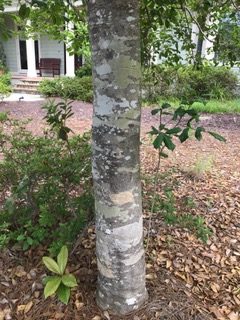Ilex opaca or American holly, is an evergreen tree that may grow 40 – 60 feet tall. It is native to eastern and central United States and is most frequently found in moist woods, forest bottom lands, swamp peripheries, and some coastal dunes. It grows on the coast from Cape Cod to Florida. American holly is an upright, pyramidal tree that matures slowly in cultivation. It is easily identified because it is the only native U.S. holly with spiny green leaves and bright red berries. The thick, leathery, deep green leaves (2 to 4 inches long) have spiny marginal teeth. The species is dioecious (male and female flowers are on separate trees). Greenish-white flowers bloom May to June (male flowers in 3 to 12-inch flowered clusters and female flowers solitary or in twos or threes). Bright red or orange fruits (1/4 to 1/2-inch diameter) ripen in the fall on pollinated female trees and persist throughout the winter. www.missouribotanicalgarden.org
The genus name comes from the Latin Quercus ilex for holm oak in reference to the foliage similarities (holm oak and many of the shrubs in the genus Ilex have evergreen leaves). American holly can be susceptible to holly leaf miner, spider mites, white fly, or scale. Potential problems can be leaf drop, scorch, or chlorosis (yellowing of leaves in high pH soils), leaf spot, root rot, tar spot, and powdery mildew. www.missouribotanicalgarden.org
The American holly grows best in acidic soil. The leaves are typically yellow in alkaline soils and have a dusty, dirty look to them. It will tolerate a broad range of soil conditions and is pollution tolerant. It will not tolerate flooding or saturated soils. Too much shade will cause the tree foliage to lose density. Part afternoon shade is best in hot summer climates. It is moderately salt tolerant and deer resistant. www.plants.ces.NCSU.edu
American holly has a high flammability rating. It is not recommended for a small garden because it needs room to grow and reach maturity. This tree provides nectar for pollinators and is a larval host plant for Henry’s Elfin (Callophrys henrici) larvae which appear from February to May and have one flight. Adult Henry’s Elfin butterflies feed on flower nectar. Its fruits are eaten by songbirds, wild turkeys, quail, white-tailed deer, squirrels, and other small mammals. Honey bees are attracted to its tiny white flowers. This tree also provides wildlife coverage during the winter. www.plants.ces.NCSU.edu
Plans are to add an American holly to the Brunswick County Botanical Garden.
Information and photos by Jeanne Pavero


